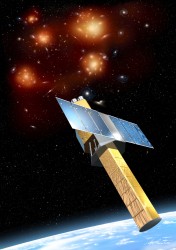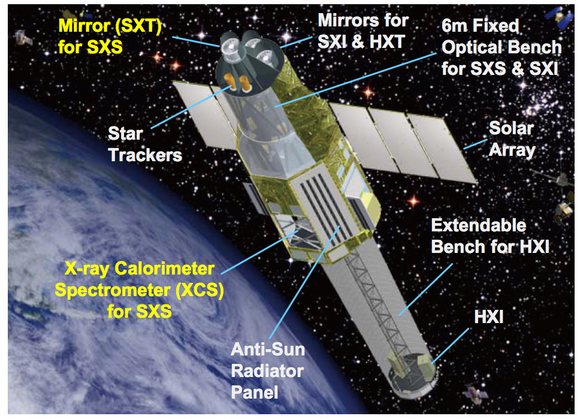Hard and soft. Dark and bright. High and low. Wide and thin. JAXA and NASA. And that’s just one spacecraft. Japan’s space agency, JAXA and NASA are teaming up to create a new spacecraft to study the extreme environments of the universe. NeXT, which stands for New exploration X-Ray Telescope is a next generation x-ray astronomy satellite currently under development, with launch scheduled in 2013. While Japan will provide the main spacecraft and several instruments, NASA, and in particular the Goddard Space Flight Center just announced they will be adding a new instrument to the spacecraft, the High-Resolution Soft X-Ray Spectrometer (SXS). While the spacecraft’s main instrument will be its Hard X-ray Telescope (HXTs) the addition of SXS is just one of several complementary instruments that provide a “yin and yang” aspect to NeXT’s explorations, which hope to reveal new facets of the universe.
The concept of yin and yang involves two opposing, but at the same time, complementary aspects of any one phenomenon, or comparison of any two phenomena. NeXT will employ both those aspects. With the addition of NASA’s SXS, NeXT will be observing both so-called “hard” and “soft” x-rays. Hard x-rays are the highest energy x-rays, typically having energies greater than 10,000 electron volts (or 10 keV) while the lower energy x-rays are referred to as soft x-rays, which have less energy and longer wavelengths. Different types of instruments are needed to detect each kind.
Conventional X-ray mirrors usually can just concentrate on only soft X-rays up to 10 keV. NeXT’s HXTs will use a “super mirror” which has a multi-layer coating on the reflecting surface in order to observe hard X-rays. The mission designers plan to utilize this technique to extend the energy band of the X-ray mirrors by nearly an order of magnitude. Observation of hard X-rays will enable the study of the various acceleration phenomena in the universe, such as dark energy, cosmic rays and supernova remnants, which astronomers say can never be completely understood through the observations of the thermal phenomena below 10 keV.

We have known for some time that cosmic X-rays are accelerated by supernova remnants. But some cosmic X-rays have energy levels so high that they cannot possibly come from a supernova remnant. These high-energy or hard cosmic X-rays may have been created when galaxy clusters evolved. According to this theory, when the galaxy clusters, which were small at first, were colliding and merging into large ones, shock waves were created, which greatly accelerated the particles. NeXT, may confirm or refute this theory.
NeXT will have both a soft x-ray telescope and soft x-ray spectrometer. With these instruments, the spacecraft can investigate the nature of dark matter on large scales in the universe, and can also explore how bright galaxies and clusters of galaxies form and evolve.
“We are thrilled to have the opportunity to create a powerful new x-ray spectrometer that will open up a whole new realm in high energy astrophysics in collaboration with our partners in Japan,” said Richard L. Kelley, the Principal Investigator for the SXS mission at Goddard. We have a great team in place that is anxiously waiting to start work.”
To compliment the x-ray telescopes there will also be Wide-band X-ray Imagers (WXI) to cover a wide energy range. Because it is difficult to cover such a wide energy range with a single detector, NeXT will use a hybrid detector, which consists of an upper-stage, soft X-ray detector and a lower-stage, hard X-ray detector. It will use thinned X-ray CCDs (charged coupled devices) for the upper stage, which stop only the soft X-rays and and a CdTe (cadmium telluride) pixel detector for the lower stage.
Also in the suite of instruments is a Soft Gamma-ray detector (SGD), which is still under development. It will include an ultra-low background, high-sensitivity detector in soft gamma-ray band by combining an active shield and an pixel detector.
Charles Gay, deputy associate administrator for NASA’s Science Mission Directorate in Washington said missions like SXS and NeXT “expand NASA’s science through partnerships with international and commercial organizations,” – just another complimentary aspect of a mission full of yin and yang.
Original News Source: NASA,


Sorry to say this but this is an odd place for that last comment. Anyway I am overjoyed to hear that American and Japanese scientists are coming together on this project. The new instruments sound incredible too. Now that we are able to study these Hard X-rays and Gamma rays we should learn a lot about the objects in space we have already studied.
Our scientists should also be trying to find other ways to use these ultra high energy particles as some of these I am sure penetrate and even possibly permeate our atmosphere and planet. Study and work together and we will find Many new and usefull things.
The first comment is very likely a SPAMbot sent out to advertise for a dating site. Perhaps the “yin” and “yang” thing is what triggered it.
Now that we are able to study these Hard X-rays and Gamma rays we should learn a lot about the objects in space we have already studied. I, too share Drakc’s enthusiasm about new insights into known X-ray emitting sources. At the same time, I am also excited about possible discoveries of completely unknown X-ray( & Gamma-ray) sources by the likes of NeXT, GLAST etc. These missions are exploring completely new portions of the electromagnetic spectrum in unprecedented detail & I’m sure some completely new astrophysical sources or mechanisms may be seen for the first time.This new breed of high energy satellites will also help explain the origin of Ultra-High Energy cosmic rays already detected by ground based observatories (HESS, MAGIC, VERITAS etc.)
It’s great that there will be a dedicated >10KeV X-ray observatory in orbit – will certainly yield some insight into some of the most interesting phenomena in the universe…
It would be an interesting exercise to compare and contrast the difference in capability of Chandra and NeXT in the 0.1 – 10 KeV region of the spectrum.